Bedienungsanleitung - Viessmann Modellspielwaren GmbH
Bedienungsanleitung - Viessmann Modellspielwaren GmbH
Bedienungsanleitung - Viessmann Modellspielwaren GmbH
Sie wollen auch ein ePaper? Erhöhen Sie die Reichweite Ihrer Titel.
YUMPU macht aus Druck-PDFs automatisch weboptimierte ePaper, die Google liebt.
2D1. Wichtige HinweiseLesen Sie vor der ersten Benutzung des Produktesbzw. dessen Einbau diese Anleitung komplettund aufmerksam durch. Bewahren Sie dieseAnleitung auf. Sie ist Teil des Produktes.Das Produkt richtig verwendenDas Produkt darf ausschließlich dieser Anleitunggemäß verwendet werden. Dieses Signalmodellist bestimmt– zum Einbau in Modelleisenbahnanlagen,– zum Betrieb an einem zugelassenen Modellbahntransformatorbzw. an einer damit versorgtenModellbahnsteuerung,– zum Betrieb in trockenen Räumen.Jeder darüber hinausgehende Gebrauch gilt alsnicht bestimmungsgemäß. Für daraus resultierendeSchäden haftet der Hersteller nicht.2. Einleitung<strong>Viessmann</strong> Lichtsignale zeichnen sich durch vorbildgerechteSignalbilder, ein hervorragendesPreis-Leistungsverhältnis sowie durch einfacheMontage und vielfältige Anschlussmöglichkeitenaus. Es sind detailgetreue Modelle der weit verbreitetenVorbild-Bauart 1969.Natürlich sind auch die <strong>Viessmann</strong> Lichtsignalefiligran detailliert und mit Metallmasten ausgestattet.Die Signalschirme sind mit wartungsfreien, energiesparendenund langlebigen LEDs bestückt.Der <strong>Viessmann</strong>-Patentsteckfuß sorgt für einfacheund schnelle Montage von oben. (Dies gilt nichtfür Spur 0 Signale.)3. SignaltechnikLichtsignalkabel zuordnenDie Anschlusskabel der Lichtsignale sind farbigmarkiert und haben an den Enden einen Widerstand.Das Kabel einer grünen LED trägt eine grüneMarkierung, das Kabel einer roten LED trägteine rote Markierung usw. Das Anschlusskabel mitschwarzer Markierung und Diode ist der gemeinsameRückleiter für alle LEDs (Pluspol).Um die verschiedenen Signaloptiken der Vorbildernachbilden zu können, besitzen manche Modellsignalemehrere LEDs der gleichen Farbe und mitgleicher Markierung.Der Abbildung 1 können Sie die Zuordnung derSignal-LEDs zu den Anschlüssen der Steuermodulebzw. der Decoder entnehmen.Viele weitere Informationen über Signale fi ndenSie im <strong>Viessmann</strong>-Signalbuch, Artikel-Nr. 5299.EN1. Important InformationPlease read this manual prior to fi rst use of theproduct resp. its installation! Keep this manual. Itis part of the product.Using the product for its correctpurposeThis product must only be used as required inthis manual. This model of a signal is intended– for installation in model railroad layouts,– for connection to an authorized model railroadtransformer or an electrical control system connectedto one,– for operation in a dry area.Using the product for any other purpose is notapproved and is considered incorrect.The manufacturer cannot be held responsible forany damage resulting from the improper use ofthis product.2. Introduction<strong>Viessmann</strong> daylight signals have some outstandingbenefi ts: Prototypical signal aspects, a verygood price-performance-ratio and they are simpleto mount and to connect. The signals are detailledmodels of the type 1969 of the Deutsche Bahn.The daylight-signals have fi nely detailed metalmasts. The signal heads have energy-saving ledswhich have a nearly inifi nite lifetime.The patented <strong>Viessmann</strong>-socket allows simpleand fast mounting. (This does not apply to 0 scalesignals.)3. Signal TechniqueWiringThe wires of the daylight signals have colouredmarkers and a resistor. The wire of a green ledhas a green marker, the wire of a red led has ared marker and so on. The wire with the blackmarker and a diode instead of a resistor is thecommon pole for all leds (plus pole).Some signals need more than one led with thesame colour to generate specifi c signal aspects(e. g. exit signal with distant signal at the samemast). These signals have different wires with thesame markers.Figure 1 shows the allocation of the signal ledsto the outputs of the control modules resp. thedecoders.You’ll fi nd much more information in the signalbookfrom <strong>Viessmann</strong> (5299 - german language).Wichtig: Widerstände und Diode an denEnden der Anschlussdrähte sind für dieFunktion erforderlich. Entfernen Sie diesekeinesfalls! Umhüllen Sie die Widerständenicht mit Isolationsmaterial, da sie sonstkeine ausreichende Kühlung erhalten!SignalbegriffeDie Signalbegriffe der Lichtsignale zeigt Abb. 2.Nicht jedes Signal kann jeden Begriff darstellen.Bezeichnung der SignaleBeigelegt ist eine Tafel mit Klebebildern (nur beiSignalen mit r.-Tafel) zur frei wählbaren Bezeichnungder Signale. Informationen zur vorbildgerechtenBeschriftung finden Sie im Signalbuch.4. Montage*1. Bohren Sie an der Montagestelle ein Loch.Durchmesser: H0, TT: 5,5 mm / N, Z: 4 mm2. Führen Sie das Anschlusskabel von obendurch das Montageloch und stecken Sie danndas Signal mit dem Patentsteckfuß hinein.Das Signal muss nun fest sitzen, lässt sich aberbei Bedarf leicht herausziehen und demontieren.*Dies gilt nicht für Spur 0 Signale.Abb. 1Abb. 2BlocksignalBlock signalAusfahrsignalExit signalEinfahrsignalEntry signalgnrt gn rt geVorsignal(Hauptsignalbegrifferwarten)Hp0 „Halt“Hp1 „Fahrt“Attention: Resistors and diode at the endof the wires are essential for the function ofthe signal. Never cut off the resistors orthe diode! Don’t cover the resistors withisolation material because they need to becooled by air.Signal aspectsFigure 2 shows the aspects of the daylight signals.Not every signal can show every aspect.Marking of signalsAdhesive signs are supplied with the signal. Simplycut out the desired sign and attach it to thesignal box after removing the protecting foil. Thesignalbook provides you with helpful information.4. Mounting*1) Drill a hole at the mounting place.Diameter: H0, TT: 5.5 mm / N, Z: 4 mm2) The signal‘s connection wires have to be insertedinto the hole first. Then put the signal withthe patented <strong>Viessmann</strong>-socket into the hole.The signal has to set tight on it’s position but youcan unmount it easily.*This does not apply to 0 scale signals.gnrt1wsgert2wsge1ge2Hp2„Langsamfahrt“Vr0 Vr1 Vr2gn2gn1Fig. 1Fig. 2Hp0 + Sh1„Zughalt+ Rangierenerlaubt“3



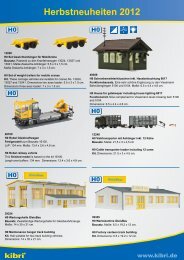
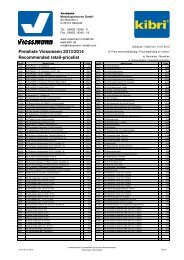

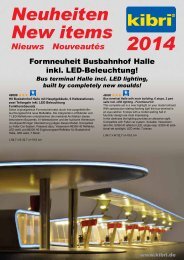
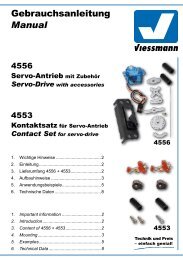
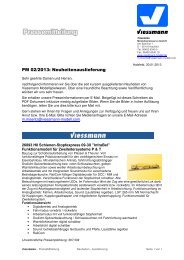


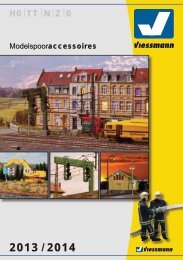
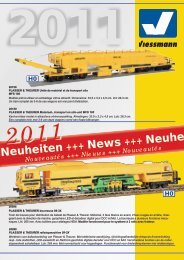
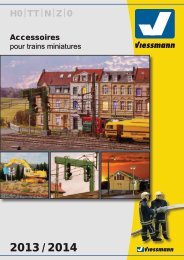
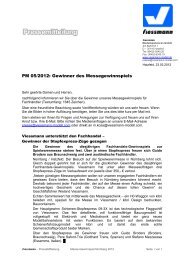
![Interactive News [pdf]](https://img.yumpu.com/13782861/1/190x107/interactive-news-pdf.jpg?quality=85)
